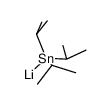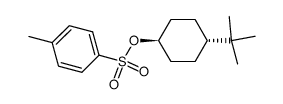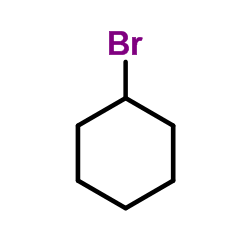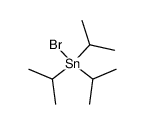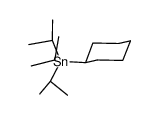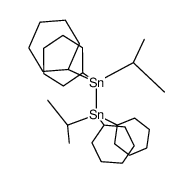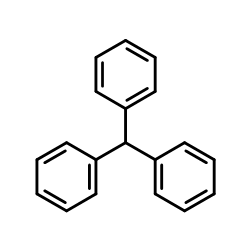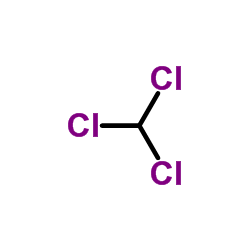2949-42-0
| 中文名 | 四异丙基锡 |
|---|---|
| 英文名 | tetra(propan-2-yl)stannane |
| 英文别名 |
TETRAISOPROPYLTIN
EINECS 220-969-5 tetraisopropyl stannane Tetraisopropylzinn STANNANE,TETRAISOPROPYL MFCD00026346 tetra-i-propyltin tetrapropan-2-ylstannane Tetraisopropyl-stannan |
| 密度 | 1.124 g/cm3 |
|---|---|
| 沸点 | 89ºC (4 torr) |
| 分子式 | C12H28Sn |
| 分子量 | 291.05200 |
| 闪点 | >38ºC |
| 精确质量 | 292.12100 |
| LogP | 5.07520 |
| 蒸汽压 | 0.0428mmHg at 25°C |
| 折射率 | 1.4851 |
| 储存条件 | 密闭于阴凉干燥环境中 |
| 稳定性 | 遵照规定使用和储存则不会分解。 |
| 分子结构 | 1、摩尔折射率:无可用 2、 摩尔体积(cm3/mol):无可用 3、 等张比容(90.2K):无可用 4、 表面张力(dyne/cm):无可用 5、 极化率:无可用 |
| 计算化学 | 1.疏水参数计算参考值(XlogP):无 2.氢键供体数量:0 3.氢键受体数量:0 4.可旋转化学键数量:4 5.互变异构体数量:无 6.拓扑分子极性表面积0 7.重原子数量:13 8.表面电荷:0 9.复杂度:108 10.同位素原子数量:0 11.确定原子立构中心数量:0 12.不确定原子立构中心数量:0 13.确定化学键立构中心数量:0 14.不确定化学键立构中心数量:0 15.共价键单元数量:1 |
| 更多 | 1. 性状:无可用 2. 密度(g/mL,25/4℃):1.124 3. 相对蒸汽密度(g/mL,空气=1):无可用 4. 熔点(ºC):无可用 5. 沸点(ºC,常压):89 6. 沸点(ºC,5.2kPa):无可用 7. 折射率:无可用 8. 闪点(ºC):>38 9. 比旋光度(º):无可用 10. 自燃点或引燃温度(ºC):无可用 11. 蒸气压(kPa,25ºC):无可用 12. 饱和蒸气压(kPa,60ºC):无可用 13. 燃烧热(KJ/mol):无可用 14. 临界温度(ºC):无可用 15. 临界压力(KPa):无可用 16. 油水(辛醇/水)分配系数的对数值:无可用 17. 爆炸上限(%,V/V):无可用 18. 爆炸下限(%,V/V):无可用 19. 溶解性:无可用 |
|
Section 1: Product Identification Chemical Name:Tetra-i-propyltin, min. 98% CAS Registry Number:2949-42-0 Formula:Sn(C3H7)4 EINECS Number:220-969-5 Chemical Family:organotin compound Synonym:Tetrakis(i-methylethyl)stannane
Section 2: Composition and Information on Ingredients IngredientCAS NumberPercentACGIH (TWA)OSHA (PEL) Title Compound2949-42-0100%0.1mg/m30.1mg/m3 Section 3: Hazards Identification Irritating to skin, eyes and respiratory tract. Organo tin compounds may act as delayed poisons, causing Emergency Overview: headache, psycho-neurologic disturbances, vision impairment; skin burns, liver and kidney damage. Primary Routes of Exposure:Ingestion, inhalation, skin, eyes Eye Contact:Causes severe irritation of the eyes. Causes slight to mild irritation of the skin. Prolonged contact may dry the skin and lead to rashes or more Skin Contact: severe irritation. Irritating to the nose, mucous membranes and respiratory tract. High doses may cause long term neurological Inhalation: damage. Delayed and permanent psycho-neurologic disturbances; impairment of vision, unsteadiness, nausea and Ingestion: vomiting. Irritating to skin, eyes and mucous membranes. Ingestion of certain organotin compounds may cause delayed Acute Health Affects: poisoning (4 days) with cerebral edema causing damage to the central nervous system. Repeated exposure to certain organic tin compounds may cause problems with vision, skin, respiratory Chronic Health Affects: system, central nervous system, liver, kidneys, urinary tract, and blood . NTP:No IARC:No OSHA:No SECTION 4: First Aid Measures Immediately flush the eyes with copious amounts of water for at least 10-15 minutes. A victim may need Eye Exposure: assistance in keeping their eye lids open. Get immediate medical attention. Wash the affected area with water. Remove contaminated clothes if necessary. Seek medical assistance if Skin Exposure: irritation persists. Remove the victim to fresh air. Closely monitor the victim for signs of respiratory problems, such as difficulty Inhalation: in breathing, coughing, wheezing, or pain. In such cases seek immediate medical assistance. Seek medical attention immediately. Keep the victim calm. Give the victim water (only if conscious). Induce Ingestion: vomiting only if directed by medical personnel. SECTION 5: Fire Fighting Measures Flash Point:no data Autoignition Temperature:no data Explosion Limits:no data Extinguishing Medium:carbon dioxide, foam or dry powder Fire fighters should be equipped with a NIOSH approved positive pressure self-contained breathing apparatus Special Fire Fighting Procedures: and full protective clothing. Hazardous Combustion andcarbon monoxide, carbon dioxide, soot, organic fumes and tin compounds. Decomposion Products: Unusual Fire or Explosion Hazards: No unusual fire or explosion hazards. SECTION 6: Accidental Release Measures Small spills can be mixed with vermiculite, ground limestone, sodium carbonate or other suitable Spill and Leak Procedures: noncombustible adsorbent and swept up. SECTION 7: Handling and Storage Handling and Storage:Store in a cool, dry, well ventilated area away from heat and direct sunlight. Keep containers tightly sealed. SECTION 8: Exposure Controls and Personal Protection Eye Protection:Always wear approved safety glasses when handling a chemical substance in the laboratory. Skin Protection:Wear protective clothing and gloves. Consult with glove manufacturer to determine the proper type of glove. Ventilation:Work with this product in a well-ventilated area, preferably a fume hood. If ventilation is not available a respirator should be worn. The use of respirators requires a Respirator Respirator: Protection Program to be in compliance with 29 CFR 1910.134. Ventilation:Work with this product in a well-ventilated area, preferably a fume hood. Additional Protection:No additional protection required. SECTION 9: Physical and Chemical Properties Color and Form:colorless liq. Molecular Weight:291.05 Melting Point:no data Boiling Point:112-114°C /18 mm Vapor Pressure:no data Specific Gravity:no data Odor:not determined Solubility in Water:insoluble SECTION 10: Stability and Reactivity Stability:air and moisture stable Hazardous Polymerization:no hazardous polymerization Conditions to Avoid:none Incompatibility:strong oxidizing agents and halogens Decomposition Products:carbon monoxide, carbon dioxide, tin oxide, and organic fumes. SECTION 11: Toxicological Information RTECS Data:Intravenous (mouse); LD50: 56 mg/kg. Carcinogenic Effects:No data available Mutagenic Effects:No data available Tetratogenic Effects:No data available SECTION 12: Ecological Information Ecological Information:No information available SECTION 13: Disposal Considerations Disposal:Dispose of according to federal, state, and local regulations. SECTION 14: Transportation Shipping Name (CFR):Non-hazardous Hazard Class (CFR):NA Additional Hazard Class (CFR):NA Packaging Group (CFR):NA UN ID Number (CFR):NA Shipping Name (IATA):Non-hazardous Hazard Class (IATA):NA Additional Hazard Class (IATA):NA Packaging Group (IATA):NA UN ID Number (IATA):NA SECTION 15: Regulatory Information TSCA:Not listed in the TSCA inventory. SARA (Title 313):Title compound not listed. Second Ingredient:none SECTION 16 - ADDITIONAL INFORMATION N/A |
|
生态学数据: 该物质对环境可能有危害,对水体应给予特别注意。 CHEMICAL IDENTIFICATION
HEALTH HAZARD DATAACUTE TOXICITY DATA
|
| 风险声明 (欧洲) | R36/37/38 |
|---|---|
| 安全声明 (欧洲) | 26-36/37/39 |
| 危险品运输编码 | UN2788 |
| 包装等级 | II |
| 危险类别 | 6.1 |
| 海关编码 | 2931900090 |
|
~23% 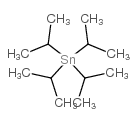
2949-42-0 |
| 文献:Sasin et al. Journal of Organic Chemistry, 1958 , vol. 23, p. 1366 |
|
~0% 
2949-42-0
详细
|
| 文献:Olszowy, Henry A.; Kitching, William Organometallics, 1984 , vol. 3, p. 1670 - 1675 |
|
~55%
详细
|
| 文献:Organometallics, , vol. 1, p. 1244 - 1246 |
|
~% 
2949-42-0 |
| 文献:Comptes Rendus Hebdomadaires des Seances de l'Academie des Sciences, , vol. 249, p. 1359 |
|
~% 
2949-42-0 |
| 文献:Comptes Rendus Hebdomadaires des Seances de l'Academie des Sciences, , vol. 240, p. 1732 |
|
~% 
2949-42-0 |
| 文献:Zeitschrift fuer Anorganische und Allgemeine Chemie, , vol. 384, p. 89 - 96 Sn: Org.Verb.1, 1.1.1.4.1, page 90 - 91 |
|
~% 
2949-42-0 |
| 文献:Bulletin de la Societe Chimique de France, , vol. 22, p. 12 Sn: Org.Verb.1, 1.1.1.4.1, page 90 - 91 |
| 上游产品 7 | |
|---|---|
| 下游产品 10 | |
| 海关编码 | 2931900090 |
|---|---|
| 中文概述 | 2931900090. 其他有机-无机化合物. 增值税率:17.0%. 退税率:13.0%. 监管条件:AB(入境货物通关单,出境货物通关单). 最惠国关税:6.5%. 普通关税:30.0% |
| Summary | 2931900090. other organo-inorganic compounds. VAT:17.0%. Tax rebate rate:13.0%. Supervision conditions:AB(certificate of inspection for goods inward,certificate of inspection for goods outward). MFN tariff:6.5%. General tariff:30.0% |




